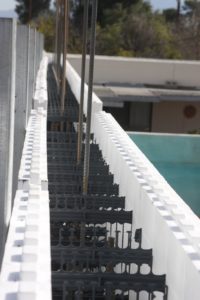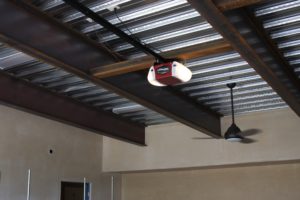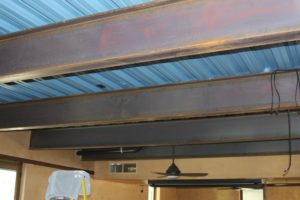Methods And Materials
In part one, we examined vibrations and the different mediums that these vibrations travel through. In part two, we examine how these vibrations produce sound in our structures by traveling through them. The way things are built and the materials used are critical in minimizing vibration transmission and incurring the appropriate sound transmission loss for our structures.
Staggered Construction Techniques
Keeping all of this in mind, a wall that is deemed “soundproof” should be two walls independently separated by air. Each sill of the two walls must be distinctive and the studs in each wall must be staggered, so that they do not line up so sound energy will see a “road” to take. Each sill must be attached to a very solid surface. This is usually concrete which is very dense and makes for a good attachment point. The sill should be isolated from the concrete further by using a damping compound. There also can be no “leaks” for acoustic energy to travel through. Acoustic or sound energy is like water, it will run to the area of its least travel resistance.
Vibrations Cause Resonances
Vibrations cause resonances. One quickly realizes the power of resonances when they deal with room modes between two parallel surfaces within their home theater, listening rooms, or professional recording studios. We have discussed how resonances can be reduced if we use mineral wool or some other type of fibrous materials. However, resonance can also be our worst enemy. Every material we use has a frequency of resonance. The exact resonant frequency will be dependent on the mass and physical dimensions. When sound energy strikes the panel and it is at the panel’s frequency of resonance, the panel will be set in motion and will start moving like a diaphragm. This minute movement will will assist in energy transmission through the structure and may even create its own sound. All multiples of the panel or wall’s resonant frequency will also be affected.
Manage Not Eliminate
We can not eliminate vibrational transmission through our structures, but we can minimize it and reduce its amplitude down to an insignificant level. To accomplish this, we use damping. Fibrous materials or damping compounds can be useful. Damping aids our vibrational transmission chain by reducing the vibrational levels of the materials it is applied to. One could say that damping prevents materials from continuing to vibrate once they have started. If we use multiple materials that are damped, we must select materials, so they do not have the same frequency of resonance. In past studio builds, lead was used extensively because it had a high mass density and it was limp so that its resonant frequency was below audibility. Now, due to health regulations, limp mass vinyl is more common although not as dense as lead.
Floors Are Always Moving,/strong>
Our floors are another room boundary surface area that must be dealt with when we are examining soundproofing. Noise sources that cause us sound energy issues are almost all connected to the floors of our home theater, listening, and professional recording studios. Footsteps are a good example of contact with the floor and most of the time our speakers sit on the floor. How about that sub woofer in our home theaters. If we want to keep the sound energy in our personal listening room from reaching the rest of the house, we should use the basement with its dense concrete floor. For a project studio, we should go to the top floor, so no one is above you.
Floors Retain Energy
Our floors contain a great deal of energy. The moment sound energy enters the floor, it will move and travel through the whole floor. Even though it is a layered structure, all layers have to be attached at some points. It is through these points of contact that energy transmission can occur. From a design standpoint and taking all of this into consideration, it is best never to let the vibrational energy into the floor at all. Carpet is a good start for footsteps. A foot stepping on a carpet will produce hardly any sound through vibration. In multiple floor apartments, carpeting is always recommended in construction drawings for this reason.
Speakers On Our Floors
Speakers provide for a completely different set of issues. Our acoustical goals with our floor standing, energy producing, speakers must be to reduce and minimize the energy produced from low frequencies by our speakers. Rugs will not be effective for our low frequencies because they are soft and low in mass, so they will allow transmission of energy especially low frequencies. One should use spikes in your speakers because the difference in abrupt change of mass at the floor and spike contact point. This small contact area will not let many vibrations through it. Spikes are not funnels for energy into the floor and out of the speaker cabinet as some spike and cone designers will tell you. Why would we want to dump all that energy into the floor and get it moving.
Floating Floors
Floating floors are a popular vibrational reducing technology. They do not really float without any point of connectivity, but their connection points are distributed throughout the floor structure surface area. A floating floor is really a completely separate structure that is isolated with neoprene supports. It is best that the sub-flooring under our floating floor be as dense as time and money will permit.
Windows And Doors
Windows and doors within our room are other portals through which sound can enter. We have all heard that an open window is a perfect absorber. It is perfect because once sound leaves through the window it never returns. On the other side, sound can enter through our closed window and the surrounding structure. Doors must be constructed of multiple layers of materials that have high sound transmission ratings. Better yet, take our multiple layered door and build two doors and separate them with a layer of air. This structure is termed a sound lock and works just like an air lock on a spaceship.
Room Planning For Vibrations
What is important in planning a room is understanding how sound is transmitted through a structure, and becoming familiar with a few of the common techniques for limiting its transmission. It is the contact points between structures in our barrier technologies that are pathways for sound transmission. To reduce vibrational pathways takes planning and calculations which are best left to a professional. One contact point between expensive structures that is not properly designed and installed can negate the performance of the whole wall.








